Serçe Limani Shipwreck Glass
The Catalogue
Serçe Limani Shipwreck Glass
Goblet with Lion Decoration
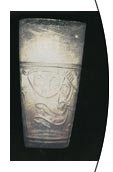 Height:
14 cm, Diameter of Rim: 7.5 cm.
Height:
14 cm, Diameter of Rim: 7.5 cm.
Found in the excavations of Serçe Limanı in 1977. Excavation inventory number:
GW 99.
Colourless transparent glass, made by free-blowing. Has thin walls and
wheel-cutting ornamentation. Has a plain, round rim, a long, cylindrical body
which tapers slightly as it descends, and a flat bottom. Decorated with a
wheel-cutter while the glass was still hot. There are two etched lion figures on
the bottom section of the cup, between two parallel horizontal bands. The lions
have broad faces, thick noses, and almond-shaped eyes. They are standing on
their hind legs, with the front legs up in the air. The body is decorated with
diagonal stripes and tail is an S-curve. In this period, relief lines made by
hot-cutting were used to give perspective to figures. This goblet, as thin as
paper, is remarkably well-preserved. There are some air bubbles in the glass,
but no weathering on the exterior surface.
Date: The Islamic Period (The State of Fatimid), 1025 AD.
Publications: Prof. Dr. Frederick H.Van Doorninck, 1990, p.58-63, photo 74;
Marilyn Jenkins, 1986, p.6-7.
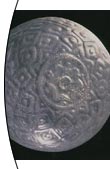 Bowl
Bowl
Height: 6.5 cm, Diameter of Rim: 14 cm.
Found in the excavations of Serçe Limanı in 1977. Excavation inventory number:
GW 109.
Light green, transparent glass, made by free-blowing. Has a round flared rim
that was polished in fire. A bright green ribbon of decorative glass encircles
the bowl just below the rim. The molded decorations begin just below the flat
lip of the bowl. They consist of raised relief squares with raised dots in the
middle. The bottom of the hemi-globe is flat, and there is a star relief in its
center. The bowl is well-preserved. It has some scratches below the rim and some
air bubbles in the glass.
Date: The Islamic Period (The State of Fatimid), 1025 AD.
Publication: F.Van Doorninck, 1990, p.58-63, photo 70.
Goblet
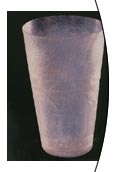 Height:
10.5 cm, Diameter of Rim: 6.5 cm, Diameter of Base: 4 cm.
Height:
10.5 cm, Diameter of Rim: 6.5 cm, Diameter of Base: 4 cm.
Found in the excavations of Serçe Limanı in 1977. Excavation inventory number:
GW 100.
Colourless transparent glass, made by mold-blowing. It is lightweight, with a
thin wall and etched decorations. The rim is irregularly cut and not exactly
round. It has a cylindrical body which tapers slightly towards the flat bottom.
Curved decorative lines are seen between two sets of horizontal bands, the upper
of which divides the goblet in half. The decorations are architectural columns
with the capitals and arches that connect them. There are also small round
decorations on the pendants of the arches. The vertical etched lines between the
columns are reminiscent of props. The cup is well-preserved, but does have some
air bubbles in the glass.
Date: The Islamic Period (The State of Fatimid), 1025 AD.
Publication: F.Van Doorninck, 1990, p.58-63, photo 68.
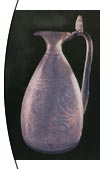 Jug
Jug
Height: 18 cm, Diameter of Belly: 9.6 cm.
Found in the excavations of Serçe Limanı in 1977. Excavation inventory number:
GW 93.
Light green, transparent glass, made by free-blowing and decorated with etching.
Has an oval shaped rim with one side shaped like a beak. The jug (small carafe)
has a thin neck, a long, oval body which widens as it descends, and one handle.
There is a pontil mark on the flattened concave bottom. The handle was attached
to the lower part of body and drawn upwards. Before attaching it to the rim, a
thumb rest was created. Thick vertical decorative lines are visible on the
shoulder of the jug. The body ornamentation is enclosed in a metope by two sets
of stripes. There are floral designs in the upper part and architectural
features, like arches and columns in the lower part of this double-sectioned
metope. The decorations are done by cutting. There are some air bubbles in the
glass and weathering on the exterior surface.
Date: The Islamic Period (The State of Fatimid), 1025 AD.
Publication: F.Van Doorninck, 1990, p.58-63, photo 71.
Jug
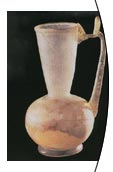 Height:
15.5 cm, Diameter of Rim: 5 cm, Diameter of Body: 7.7 cm, Diameter of Bottom:
5.5 cm.
Height:
15.5 cm, Diameter of Rim: 5 cm, Diameter of Body: 7.7 cm, Diameter of Bottom:
5.5 cm.
Found in the excavations of Serçe Limanı in 1977. Excavation inventory number:
GW 94.
Light yellow-green, transparent glass, made by free-blowing. Has a thick, round,
fire-polished rim, a funnel-shaped neck which tapers downwards to join a
globular body. It has a flat bottom. One end of the handle is attached to the
body, the other to the rim. A piece of glass was drawn upwards by a tool and
left in place for use as a thumb-rest. There are some air bubbles in the glass
and weathering on the exterior surface.
Date: The Islamic Period (The State of Fatimid), 1025 AD.
Publication: F.Van Doorninck, 1990, p.58-63, photo 71.
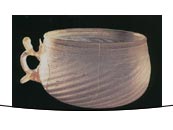 Bowl-Cup
Bowl-Cup
Height: 6.5 cm, Diameter of Rim: 11 cm.
Found in the excavations of Serçe Limanı in 1977. Excavation inventory number:
GW 106.
Yellow transparent glass, made by mold-blowing. Has a round, plain rim which is
encircled by dark yellow glass ribbons, with a few more thin threads just below
them. There are diagonal relief grooves decorations on the hemispherical body.
The single is placed vertically on the body. An upper and lower spur were
fashioned on the handle both to strengthen the handle and to make it easier to
hold. There is some decoration and a pontil mark in the middle of flat bottom.
The body of the cup is cracked and one part is broken and missing.
Date: The Islamic Period (The State of Fatimid), 1025 AD.
Publication: F.Van Doorninck, 1990, p.58-63, photo 69.
Cup
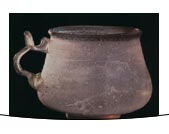 Height:
5.8 cm, Width: 6.5cm, Diameter of Bottom: 3 cm.
Height:
5.8 cm, Width: 6.5cm, Diameter of Bottom: 3 cm.
Found in the excavations of Serçe Limanı in 1977. Excavation inventory number:
GW 105.
Pink-beige, transparent glass, made by free-blowing. A drinking cup, with a
plain, round, rim encircled with a bright green band of glass, and decorated
with thin lines just below the glass band. The cylindrical body expands slightly
toward the bottom. The single handle is curved, attached to the lower part of
body, folded over to create a finger-rest and then attached to the rim. There is
a flattened tubular base-ring on the bottom. There are some air bubbles and
diagonal scratches on the glass.
Date: The Islamic Period (The State of Fatimid), 1025 AD.
Publication: F.Van Doorninck, 1990, p.58-63, photo 69.
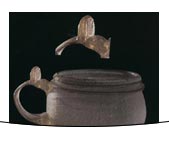 Cup
Cup
Height: 4.4 cm, Diameter of Body: 6.2 cm.
Found in the excavations of Serçe Limanı in 1978. Excavation inventory number:
GW 243.
Light yellow-beige, transparent glass, made by free-blowing. Has a plain, round
rim, encircled by two parallel bright green band just below the rim. There is
another decorative ring on neck of the cup. The cylindrical body expands
slightly through to the bottom. The handle is attached to the lower part of
body, drawn up and folded over to create a spur-shaped finger-rest, and then
attached the rim. There is a flattened tubular base-ring on the bottom. There
are some air bubbles and diagonal scratches in the glass.
Date: The Islamic Period (The State of Fatimid), 1025 AD.
Publication: F.Van Doorninck, 1990, p.58-63, photo 69.
Goblet
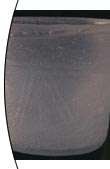 Height:
5.3 cm, Diameter of Rim: 5.8 cm, Diameter of Bottom: 4.7 cm.
Height:
5.3 cm, Diameter of Rim: 5.8 cm, Diameter of Bottom: 4.7 cm.
Found in the excavations of Serçe Limanı in 1978. Excavation inventory number:
GW 149.
Very light greenish-beige, transparent glass, made by free-blowing and decorated
by the wheel-cutting technique. Has a round, slightly flared rim, which was
polished in fire. A squat cup with a cylindrical body, it has zigzag decoration
made with two parallel lines. The zigzag is arranged between two parallel
horizontal lines that encircle the cup. There are some ornamental grooves cut
into the triangular fields created by the zigzag design. The bottom is slightly
flattened and concave. The air bubbles in the glass are very evident.
Date: The Islamic Period (The State of Fatimid), 1025 AD.
Publication: F.Van Doorninck, 1990, p.58-63, photo 68.